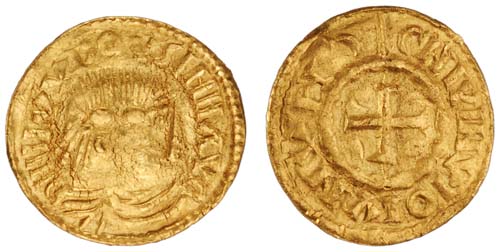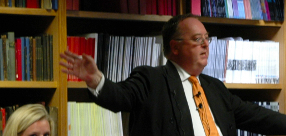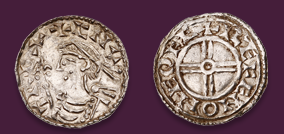
Auction: 9017 - Ancient, British & Foreign Coins & Comm Medals
Lot: 476
Anglo-Frisian, Solidus, 4.42g, c.825-850, imitating a Solidus, c.816, of Louis the Pious (814-840), laureate, draped bust right with long vertical bar for nose, fine hairlines, inverted trefoil for eye, dn lvvdovs inii avg, (dn lvdovicvs imp avg), rev. suspended wreath containing a large cross pattée linked to wreath on vertical axis, nivnivio ivnvm (mvnus divinvm) (Grierson Group III- cf Paris, Bibliotheque Nationale, Prou, no. 1075- different dies), in good style, with high gold content, creasing from coin having been straightened, very fine, an example of a ninth century gold coin from Anglo-Saxon England, only one other known of this type, extremely rare Estimate £ 8,000-10,000 provenance Found March 2009, near Salisbury Whilst coinage in Northern Europe and England in the ninth century was predominantly silver there is substantial evidence for a smaller gold coinage. In all around 100 examples of gold coins exist from this period with most from continental find spots, however a small number have been found in England, with two in the name of the English rulers, Coenwulf of Mercia and Archbishop Wigmund of York. Gold coins from this period are all very rare, with examples from England extremely rare. The majority of surviving gold coins from this period in Northern Europe are based on the gold Solidus struck by Louis the Pious c.816 which was copied extensively in the North Sea area. Most surviving examples of these come from three hoards found in the Netherlands, however a small group, derive from the British Isles. This is the twelfth example of an imitation of the gold Solidus of Louis the Pious to have been found in Britain. Of these seven, including this new example, are from locations within England. This new find is therefore a further indication that these imitations of the Louis the Pious Solidus were probably in use alongside other gold coins, such as the famous Coenwulf Mancus (see Spink auction 170, lot 493), and silver pennies struck by Anglo Saxon rulers in ninth century England. This piece and the Coenwulf Mancus have similar weights at 4.42g and 4.33g respectively. Other complete examples of English found imitation Louis the Pious Solidi all fall within a weight range 4.30g-4.56g, so it is conceivable that these also circulated as Mancuses. This is further supported by a Mancus being worth 30 silver pennies and a Gold to silver ratio of 9:1, thought acceptable by some scholars for this time, matches a penny weight at 1.3g which is more or less the average Anglo Saxon penny weight in the first half of the ninth century. Within the English finds of imitation gold Solidi there is a cluster of three coins (Grierson Group XVI) which share the same dies, which have long been thought to have been produced in England. The find more recently of a lead trial piece for an imitation Solidus at Torksey adds further evidence for there being English produced imitations of the Louis the Pious Solidus. This new coin has similarities to those in the English cluster of three but the execution of the wreath, bust and inscriptions are in better style. With the only similar coin, Grierson Group III, in the Bibliotheque Nationale in Paris (with no find provenence and from different dies), the case for this coin being struck in England is less sure, but this does remain a distinct possibility. (A further coin sold at an East Anglian auction house earlier this year is of a quite different style and does not match this coin or the cluster of three.) Corpus of Louis the Pious imitation Solidi found in England; 1. Fitzwilliam Museum, Cambridge, found in the river Cam, Cambridge, before 1904, 4.30g, Same dies as 2 and 3. 2. Ashmolean Museum, Oxford, found at Lewes, 1884, 4.33g. Same dies as 1 and 3. 3. British Museum, found at Therfield, nr. Royston, Herts, before 1860, 4.59g. Same dies as 1 and 2. 4. Sotheby, 25 March 1850, lot 247, found Portchester, Hants, 1832, whereabouts not known. 5. Southampton Museum, Southampton excavations, 1971, 4.56g. 6. Richard Falkiner Collection, found Stamford Bridge, Yorks, early 1940s, 4.08g. Christies Auction 17 November 1970, lot 46a. 7. Lockdale Coins Ltd, auction 70, 29 January 2009, lot 810, probably found in Norfolk, 4.2g.
Sold for
£8,000




